用掺硼金刚石(BDD)电极的电化学氧化协同作用和臭氧(O3)的工业废水处理
- 格式:pdf
- 大小:296.25 KB
- 文档页数:4
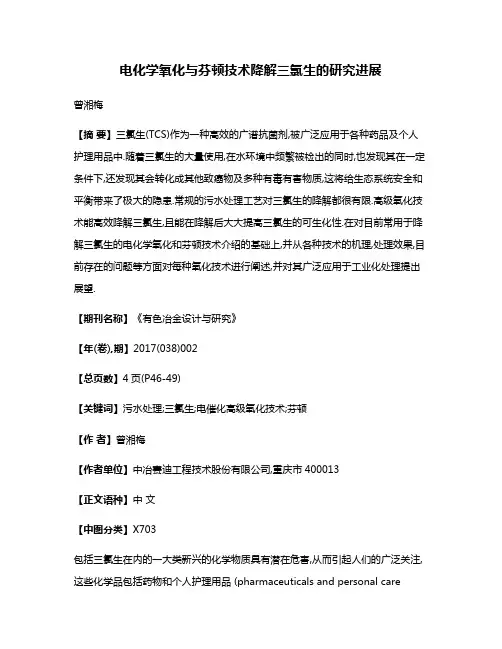
电化学氧化与芬顿技术降解三氯生的研究进展曾湘梅【摘要】三氯生(TCS)作为一种高效的广谱抗菌剂,被广泛应用于各种药品及个人护理用品中.随着三氯生的大量使用,在水环境中频繁被检出的同时,也发现其在一定条件下,还发现其会转化成其他致癌物及多种有毒有害物质,这将给生态系统安全和平衡带来了极大的隐患.常规的污水处理工艺对三氯生的降解都很有限.高级氧化技术能高效降解三氯生,且能在降解后大大提高三氯生的可生化性.在对目前常用于降解三氯生的电化学氧化和芬顿技术介绍的基础上,并从各种技术的机理,处理效果,目前存在的问题等方面对每种氧化技术进行阐述,并对其广泛应用于工业化处理提出展望.【期刊名称】《有色冶金设计与研究》【年(卷),期】2017(038)002【总页数】4页(P46-49)【关键词】污水处理;三氯生;电催化高级氧化技术;芬顿【作者】曾湘梅【作者单位】中冶赛迪工程技术股份有限公司,重庆市400013【正文语种】中文【中图分类】X703包括三氯生在内的一大类新兴的化学物质具有潜在危害,从而引起人们的广泛关注,这些化学品包括药物和个人护理用品 (pharmaceuticals and personal careproducts,简称PPCPs)[1]。
直到1999年在美国环境保护总署(EPA)支持下,Daugh ton和Ternes (1999)[2]发表了一篇关于药品及个人护理用品的综述文章,PPCPs污染才得以正式被提出[1]。
三氯生(TCS)作为药品与个人护理品(PPCPs)中的添加物,是一种国际流行的广谱抗菌剂。
由于它们与皮肤有极好的相容性,对革兰氏阳性菌、革兰氏阴性菌、真菌、酵母菌、病毒等也都有高效抑杀作用,因此被广泛应用于纺织品、塑料、肥皂、化妆品、牙膏和伤口消毒剂等类产品中,起到杀菌、抑菌和除臭的作用[3]。
三氯生是一种潜在的持久性有机污染物(Persistent organic pollutants,POPS),其亲水性低,亲脂性强,pH为7时,log Kow为4.8[4],物理化学性质稳定,在环境中较难降解。
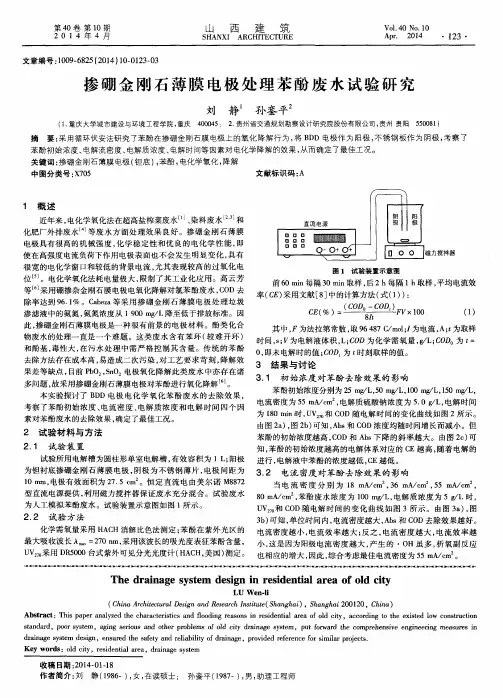


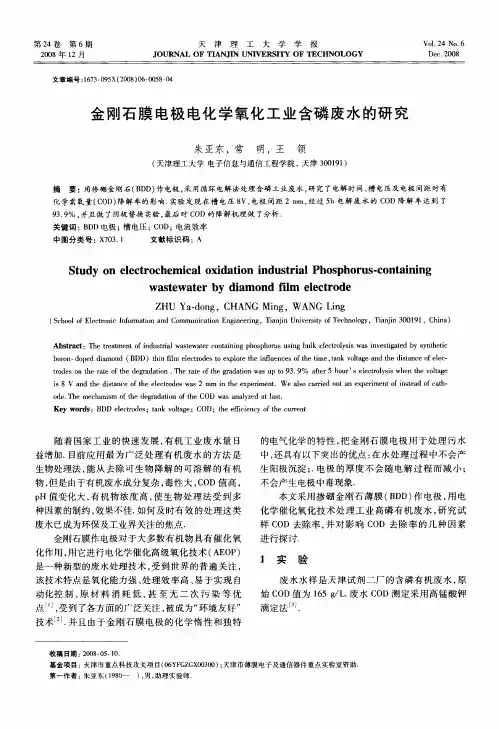

污水处理高级氧化技术近年来,由于工业化发展的速度较快,致使工业企业的污水排放量剧增,造成的环境污染问题越来越严重。
在工业生产排放的废水中,有机废水的浓度较高、成分繁杂,且具有难降解、含毒性物质等特征。
因此,传统的污水处理技术已无法满足当今的污水处理要求,所以,有效处理此类工业废水已成为当务之急。
目前,先进的高级氧化法处理效果好、反应速度快、二次污染概率小且适用范围广。
因此,该技术已逐步应用于各种工业废水处理工艺中。
该技术按反应原理划分可分为臭氧氧化、光化学氧化、催化湿式氧化、电化学氧化、芬顿氧化等。
1、高级氧化法处理废水的研究进展1.1 臭氧氧化(1)臭氧氧化按照对污染物和臭氧的化学反应方式的不同,可分成二类。
一类是用臭氧直接和有机化合物反应,一般称为臭氧直接反应;另一类是臭氧先经过分解形成羟基自由基,再通过羟基自由基和有机产物进行直接化学反应,一般称为臭氧发生器间接化学反应。
在实际应用中,与臭氧的直接反应通常是通过打破有机物的双键结合,将大分子有机质转变为小分子,但总体氧化程度并不高,而破碎成小分子的有机物具备了较大的可生化性。
臭氧直接氧化是由于其选择能力较强、化学反应速度慢、以及对污染物的全面净化难度较大等特点,但可以对工业废水进行预处理,以此提高废水的B/C比。
而臭氧的间接处理化学反应基本原理为:臭氧在水体内先溶解形成羟基自由基(OH),然后羟基自由基再去氧化有机物。
该方法一般不具备化学选择性,但由于反应速度快、氧化程度高、污水处理效率好等优点,在工业废水处理中取得了较普遍的运用。
在臭氧处理间接化学反应中,臭氧在水体形成羟基自由基主要采用两种路径:①在碱性条件下,臭氧迅速溶解形成羟基自由基,且在紫外线光的影响下,臭氧形成羟基自由基;②在各种金属催化的影响下,臭氧形成羟基自由基。
国内学者对催化剂展开研究,以负载式二氧化钛为催化剂,对臭氧化合物在强催化作用下氧化对水溶性元素腐殖酸的影响开展了深入研究,结果显示,利用二氧化物能够增加对臭氧的氧化效果,其效果增加到了29.1%,而最终的腐植酸氧化物去除率更高达84.9%。
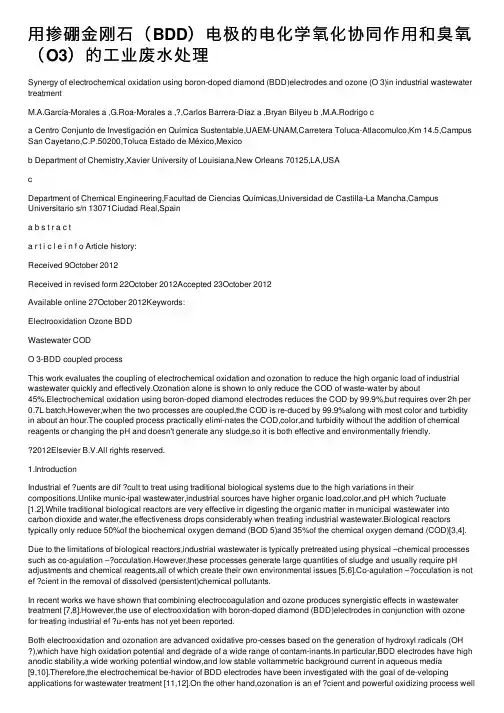
⽤掺硼⾦刚⽯(BDD)电极的电化学氧化协同作⽤和臭氧(O3)的⼯业废⽔处理Synergy of electrochemical oxidation using boron-doped diamond (BDD)electrodes and ozone (O 3)in industrial wastewater treatmentM.A.García-Morales a ,G.Roa-Morales a ,?,Carlos Barrera-Díaz a ,Bryan Bilyeu b ,M.A.Rodrigo ca Centro Conjunto de Investigación en Química Sustentable,UAEM-UNAM,Carretera Toluca-Atlacomulco,Km 14.5,Campus San Cayetano,C.P.50200,Toluca Estado de México,Mexicob Department of Chemistry,Xavier University of Louisiana,New Orleans 70125,LA,USAcDepartment of Chemical Engineering,Facultad de Ciencias Químicas,Universidad de Castilla-La Mancha,Campus Universitario s/n 13071Ciudad Real,Spaina b s t r a c ta r t i c l e i n f o Article history:Received 9October 2012Received in revised form 22October 2012Accepted 23October 2012Available online 27October 2012Keywords:Electrooxidation Ozone BDDWastewater CODO 3-BDD coupled processThis work evaluates the coupling of electrochemical oxidation and ozonation to reduce the high organic load of industrial wastewater quickly and effectively.Ozonation alone is shown to only reduce the COD of waste-water by about45%.Electrochemical oxidation using boron-doped diamond electrodes reduces the COD by 99.9%,but requires over 2h per 0.7L batch.However,when the two processes are coupled,the COD is re-duced by 99.9%along with most color and turbidity in about an hour.The coupled process practically elimi-nates the COD,color,and turbidity without the addition of chemical reagents or changing the pH and doesn't generate any sludge,so it is both effective and environmentally friendly.2012Elsevier B.V.All rights reserved.1.IntroductionIndustrial ef ?uents are dif ?cult to treat using traditional biological systems due to the high variations in their compositions.Unlike munic-ipal wastewater,industrial sources have higher organic load,color,and pH which ?uctuate[1,2].While traditional biological reactors are very effective in digesting the organic matter in municipal wastewater into carbon dioxide and water,the effectiveness drops considerably when treating industrial wastewater.Biological reactors typically only reduce 50%of the biochemical oxygen demand (BOD 5)and 35%of the chemical oxygen demand (COD)[3,4]. Due to the limitations of biological reactors,industrial wastewater is typically pretreated using physical –chemical processes such as co-agulation –?occulation.However,these processes generate large quantities of sludge and usually require pH adjustments and chemical reagents,all of which create their own environmental issues [5,6].Co-agulation –?occulation is not ef ?cient in the removal of dissolved (persistent)chemical pollutants.In recent works we have shown that combining electrocoagulation and ozone produces synergistic effects in wastewater treatment [7,8].However,the use of electrooxidation with boron-doped diamond (BDD)electrodes in conjunction with ozone for treating industrial ef ?u-ents has not yet been reported.Both electrooxidation and ozonation are advanced oxidative pro-cesses based on the generation of hydroxyl radicals (OH ),which have high oxidation potential and degrade of a wide range of contam-inants.In particular,BDD electrodes have high anodic stability,a wide working potential window,and low stable voltammetric background current in aqueous media[9,10].Therefore,the electrochemical be-havior of BDD electrodes have been investigated with the goal of de-veloping applications for wastewater treatment [11,12].On the other hand,ozonation is an ef ?cient and powerful oxidizing process wellknown for its degradation of organic compounds.The limitations to these processes are the time required for electrooxidation and the ef-fectiveness of ozonation,so neither alone is truly industrially practical.Thus,this study evaluates the synergy of the two processes com-pared to the ef ?ciency and effectiveness of the individual ones.The effectiveness is evaluated in terms of color,turbidity and chemical ox-ygen demand (COD)reduction.The in ?uence of operating parame-ters such as time of treatment,current density,and initial pH is also evaluated.2.Materials and methods 2.1.Wastewater samplesWastewater samples were collected from the treatment plant of an industrial park,which receives the discharge of144different facil-ities.Therefore,the chemical composition of this ef ?uent is ratherElectrochemistry Communications 27(2013)34–37Corresponding author.Tel.:+527222173890;fax:+527222175109.E-mail address:groam@uaemex.mx (G.Roa-Morales).1388-2481/$–see front matter ?2012Elsevier B.V.All rights reserved./10.1016/j.elecom.2012.10.028Contents lists available at SciVerse ScienceDirectElectrochemistry Communicationsj o ur n a l h o m e p a g e :w w w.e l s e v i e r.c o m /l o c a t e /e l e c o mcomplex.Samples were collected in plastic containers and cooled down to4°C,then transported to the laboratory for analysis and treatment.The pH of the raw wastewater is8.24and all treatment and testing were done at this value.2.2.Electrooxidation reactorA batch cylindrical electrochemical reactor was set up for the elec-trochemical process.The reactor cell contains a pair of BDD electrodes (BDD?lm supported on a niobium substrate),each electrode was 20.0cm by2.5cm with a surface areaof50cm2.Batch volumes of 0.70L were treated in the1.00L reactor.A direct-current power source supplied the systemwith0.5,1.0,and1.5A,corresponding to current densities of10,20,and30mA/cm2.2.3.Ozonation reactorThe ozone experiments were conducted in a1.5L glass reactor at18°C.Ozone was supplied by a Paci?c Ozone Technology generator. The gas was fed into the reactor through a porous plate situated at the reactor bottom.The ozone concentration at the gas inlet and out-let of the reactor was measured by redirecting the?ow to a series of ?asks containing0.1M potassium iodide.The mean concentration of ozone in the gas phase was5±0.5mg/L and was measured imme-diately before each run.Ozonation experiments were carried out at the pH of raw wastewater and samples were taken at regular inter-vals to determine COD.2.4.Synergy of electrooxidation/O3processFor the combined system the pair of BDD electrodes from the electrooxidation reactor was installed in the ozonereactor.Ozone was introduced at the same rate and the BDD electrodes were given the same current densities as in the individual reactors.Treated sam-ples were taken at the same intervals and were analyzed in the same way.2.5.Methods of analysisThe initial evaluations of the electrochemical,ozonation,and inte-grated treatments were determined by analysis of theCOD(mg/L), color(Pt–Co scale),and turbidity(NTU scale).COD was determined by the open re?ux method according to the American Public Health Association(APHA).Following this method,samples are re?uxed with potassium dichromate and sulfuric acid for2h.Once the opti-mal conditions were found the raw and treated wastewater samples were analyzed using the standard methods for the examination of water and wastewater procedures.[13].3.Results and discussion3.1.Electrooxidation treatmentThe COD reduction(%)as function of electrooxidation treatment time on the raw wastewater is shown in Fig.1.The maximum COD re-duction of99.9%was observed at140min of treatment.3.2.Ozonation treatmentOzone was introduced into the sample at a concentration of5±0.5mg/L and the COD was measured as a function of time.As shown in Fig.2,the maximum COD reduction was45%at120min of treatment time.3.3.Synergy of electrooxidation/O3processThe effect of coupling electrooxidation and ozonation processes was studied through a series of experiments using the COD reduction as a function of treatment time for the raw wastewater.In Fig.3the effect of variation on the current density values is also described. The maximum COD reduction of99.9%occurs at60min.A comparative graph of the COD reduction as a function of treat-ment time among the three treatments indicates that ozone is not as effective and electrooxidation takes longer than the coupled pro-cess(Fig.4).The UV–vis spectra of the raw and treated wastewater are shown in Fig.5.The raw wastewater shows considerable absorbance in the visible range of300to630nm which con?rms that it is highly col-ored.However,this color is effectively removed by the coupled treatment.The reduction in the values of some physicochemical parameters of the raw and treated wastewater is shown in Table1.As shown in Table1,the coupled process reduces and practically eliminates the organic pollutants in the wastewater.The high levels of COD,color,and turbidity are effectively reduced without any addi-tion of chemical reagents and without adjusting the pH.The coupled process also increases the ef?ciency of the organic removal by reduc-ing the treatment time.Thus the two processes act synergistically in the coupled process.Previous research[14]indicates that the oxidation of organics with concomitant oxygen evolution assumes that both organicoxidation Fig.1.COD removal as a function of electrooxidation treatment time at10mA/cm2.Fig.2.COD removal as a function of ozonation(5±0.5mg/L)treatment time.35M.A.García-Morales et al./Electrochemistry Communications27(2013)34–37and oxygen evolution take place on a BDD anode surface via intermedi-ation of hydroxyl radicals,generated from the reaction with water shown in Eqs.(1)and (2):BDD tH 2O →BDD eOH ?TtH ttee1TBDD eOH ?TtR →BDD tmCO 2tnH 2O :e2TReaction (2)is in competition with the side reaction of hydroxyl radical conversion to O 2without any participation of the anode sur-face as indicated in Eq.(3)BDD eOH ?T→BDD t1=2O 2tH tte ?:e3TThe ozone contribution can be attributed to the electrophilic na-ture of the direct attack by O 3molecules (Eq.(5))and the indirect at-tack via OH ?radicals in the ozonation process (Eq.(6)).According to Tomiyasu et al.[15]the ozonation effect may be ini-tiated by the following reactions:O 3tH 2O →2HO ?tO 2e4TO 3tOH →O ?2?tHO ?2e5TO 3tOH ?→HO ?2tO 2:e6TAccording to the literature,the pH value of the solution signi ?-cantly in ?uences ozone decomposition in water since basic pH causes an increase of ozone decomposition.At pH b 3hydroxyl radicals do not in ?uence the decomposition of ozone.For 7b pH b 10,the typical half-life of ozone is 15to 25min.[16].4.ConclusionsThe combination of electrooxidation and ozonation processes re-sults in a synergy that greatly enhances the rate and extent of remov-al of COD,color,and turbidity from a chemically complex industrial ef ?uent.Electroxodiation alone reduces the COD to less than 1%of the initial,but requires a relatively long time of 140min.On the other hand,ozonation alone only reduces it to 45%.When the coupled electrooxidation –ozonation process is used a maximum 99.9%of COD is removed in only 60min under the optimal conditions:pH 8.24,with 5±0.5mg/L of ozone concentration,and 30mA/cm 2of current density.While electrooxidation ef ?ciency usually increases with in-creasing current density,the coupled process is more ef ?cient at a rel-atively low (mA/cm 2)current density.AcknowledgmentsThe authors wish to acknowledge the support given by the Centro Conjunto de Investigación en QuímicaSustentable,UAEM-UNAM,and ?nancial support from the CONACYT through the projects 168305and 153828is greatlyappreciated.Fig.3.COD removal when coupling electrooxidation and ozonation processes at three different current densities (▲)30mA/cm 2(○)20mA/cm 2(?)10mA/cm 2.Fig.4.COD removal as a function of treatment time of (?)coupled,(Δ)electrooxidation and (■)ozonetreatment.Fig.5.UV –vis spectra of the (——)raw and (----)treated industrial wastewater.The parameters of the coupled treatment were 30mA/cm 2and 5±0.5mg/L of ozone.Table 1Physicochemical parameters of the raw and treated industrial wastewater.Parameter Raw wastewater Treated wastewater COD/mg L ?1534b 1Color/Pt –Co units 880b 50Turbidity/NTU52b 536M.A.García-Morales et al./Electrochemistry Communications 27(2013)34–37References[1] C.A.Martinez,E.Brillas,Applied Catalysis B:Environmental87(2009)105.[2] C.Barrera-Díaz,F.Ure?a-Nu?ez,E.Campos,M.Palomar-Pardavé,M.Romero-Romo,Radiation Physics and Chemistry67(2003)657.[3]V.Agridiotis,C.Forster,C.Balaboine,C.Wolter,C.Carliell-Marquet,Water Envi-ronment Journal20(2006)141.[4] C.J.Van der Gast,B.Jefferson,E.Reid,T.Robinson,M.J.Bailey,S.J.Judd,I.P.Thompson,Environmental Microbiology8(6)(2006)1048.[5] F.Hana?,O.Assobhei,M.Mountadar,Journal of Hazardous Materials174(2010)807.[6] C.Barrera-Díaz,I.Linares-Hernández,G.Roa-Morales,B.Bilyeu,P.Balderas-Hernández,Industrial and Engineering Chemistry Research48(2009)1253. [7]L.A.Bernal-Martinez, C.Barrera-Díaz, C.Sólis-Morelos,R.Natividad-Rangel,Chemical Engineering Journal165(2010)71.[8]M.A.García-Morales,G.Roa-Morales,C.Barrera-Díaz,P.Balderas-Hernández,Journal of Environmental Science and Health,Part A47(2012)22.[9]J.Sun,H.Lu,L.Du,H.Lin,H.Li,Applied Surface Science257(2011)6667.[10] F.L.Migliorini,N.A.Braga,S.A.Alves,nza,M.R.Baldan,N.G.Ferreira,Journalof Hazardous Materials192(2011)1683.[11]M.Panizza,P.A.Michaud,G.Cerisola,ninellis,Electrochemistry Communi-cations3(2001)336.[12] A.Morao,A.Lopes,M.T.Pessoa de Amorim,I.C.Goncalves,Electrochimica Acta49(2004)1587.[13]APHA,AWWA,Standard Methods for the Examination of Water and Wastewater,16th edition American Public Health Association,Washington DC,1995.[14] A.Kapalka,G.Fóti,ninellis,Electrochimica Acta53(2007)1954.[15]H.Tomiyasu,H.Fukutomi,G.Gordon,Inorganic Chemistry24(1985)2962.[16] B.Kasprzyk,M.Ziolek,J.Nawrocki,Applied Catalysis B:Environmental46(2003)639.37M.A.García-Morales et al./Electrochemistry Communications27(2013)34–37。
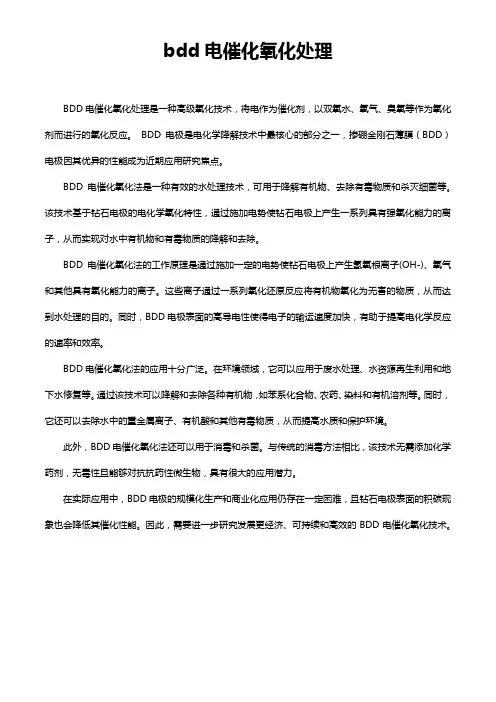
bdd电催化氧化处理
BDD电催化氧化处理是一种高级氧化技术,将电作为催化剂,以双氧水、氧气、臭氧等作为氧化剂而进行的氧化反应。
BDD电极是电化学降解技术中最核心的部分之一,掺硼金刚石薄膜(BDD)电极因其优异的性能成为近期应用研究焦点。
BDD电催化氧化法是一种有效的水处理技术,可用于降解有机物、去除有毒物质和杀灭细菌等。
该技术基于钻石电极的电化学氧化特性,通过施加电势使钻石电极上产生一系列具有强氧化能力的离子,从而实现对水中有机物和有毒物质的降解和去除。
BDD电催化氧化法的工作原理是通过施加一定的电势使钻石电极上产生氢氧根离子(OH-)、氧气和其他具有氧化能力的离子。
这些离子通过一系列氧化还原反应将有机物氧化为无害的物质,从而达到水处理的目的。
同时,BDD电极表面的高导电性使得电子的输运速度加快,有助于提高电化学反应的速率和效率。
BDD电催化氧化法的应用十分广泛。
在环境领域,它可以应用于废水处理、水资源再生利用和地下水修复等。
通过该技术可以降解和去除各种有机物,如苯系化合物、农药、染料和有机溶剂等。
同时,它还可以去除水中的重金属离子、有机酸和其他有毒物质,从而提高水质和保护环境。
此外,BDD电催化氧化法还可以用于消毒和杀菌。
与传统的消毒方法相比,该技术无需添加化学药剂,无毒性且能够对抗抗药性微生物,具有很大的应用潜力。
在实际应用中,BDD电极的规模化生产和商业化应用仍存在一定困难,且钻石电极表面的积碳现象也会降低其催化性能。
因此,需要进一步研究发展更经济、可持续和高效的BDD电催化氧化技术。
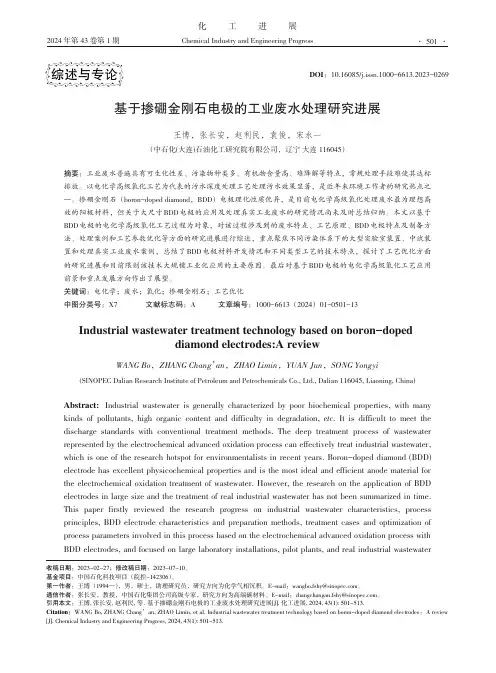
化工进展Chemical Industry and Engineering Progress2024 年第 43 卷第 1 期基于掺硼金刚石电极的工业废水处理研究进展王博,张长安,赵利民,袁俊,宋永一(中石化(大连)石油化工研究院有限公司,辽宁 大连 116045)摘要:工业废水普遍具有可生化性差、污染物种类多、有机物含量高、难降解等特点,常规处理手段难使其达标排放。
以电化学高级氧化工艺为代表的污水深度处理工艺处理污水效果显著,是近年来环境工作者的研究热点之一。
掺硼金刚石(boron-doped diamond ,BDD )电极理化性质优异,是目前电化学高级氧化处理废水最为理想高效的阳极材料,但关于大尺寸BDD 电极的应用及处理真实工业废水的研究情况尚未及时总结归纳。
本文以基于BDD 电极的电化学高级氧化工艺过程为对象,对该过程涉及到的废水特点、工艺原理、BDD 电极特点及制备方法、处理案例和工艺参数优化等方面的研究进展进行综述,重点聚焦不同污染体系下的大型实验室装置、中试装置和处理真实工业废水案例,总结了BDD 电极材料开发情况和不同类型工艺的技术特点,探讨了工艺优化方面的研究进展和目前限制该技术大规模工业化应用的主要原因。
最后对基于BDD 电极的电化学高级氧化工艺应用前景和重点发展方向作出了展望。
关键词:电化学;废水;氧化;掺硼金刚石;工艺优化中图分类号:X7 文献标志码:A 文章编号:1000-6613(2024)01-0501-13Industrial wastewater treatment technology based on boron-dopeddiamond electrodes:A reviewWANG Bo ,ZHANG Chang ’an ,ZHAO Limin ,YUAN Jun ,SONG Yongyi(SINOPEC Dalian Research Institute of Petroleum and Petrochemicals Co., Ltd., Dalian 116045, Liaoning, China)Abstract: Industrial wastewater is generally characterized by poor biochemical properties, with manykinds of pollutants, high organic content and difficulty in degradation, etc . It is difficult to meet the discharge standards with conventional treatment methods. The deep treatment process of wastewater represented by the electrochemical advanced oxidation process can effectively treat industrial wastewater, which is one of the research hotspot for environmentalists in recent years. Boron-doped diamond (BDD) electrode has excellent physicochemical properties and is the most ideal and efficient anode material for the electrochemical oxidation treatment of wastewater. However, the research on the application of BDD electrodes in large size and the treatment of real industrial wastewater has not been summarized in time. This paper firstly reviewed the research progress on industrial wastewater characteristics, process principles, BDD electrode characteristics and preparation methods, treatment cases and optimization of process parameters involved in this process based on the electrochemical advanced oxidation process with BDD electrodes, and focused on large laboratory installations, pilot plants, and real industrial wastewater综述与专论DOI :10.16085/j.issn.1000-6613.2023-0269收稿日期:2023-02-27;修改稿日期:2023-07-10。
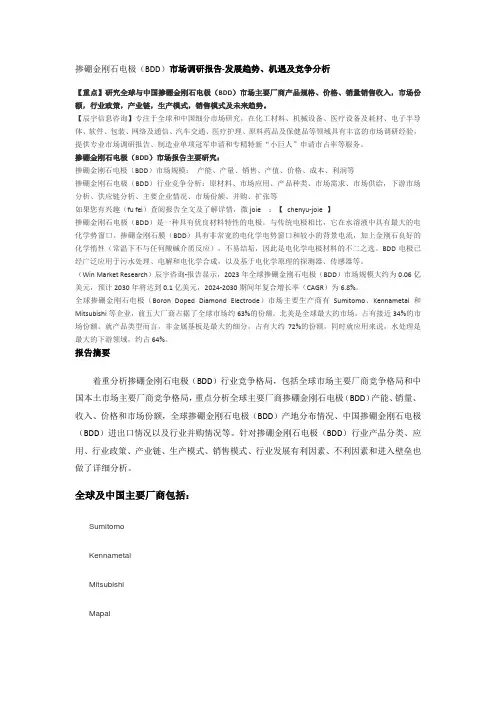
掺硼金刚石电极(BDD)市场调研报告-发展趋势、机遇及竞争分析【重点】研究全球与中国掺硼金刚石电极(BDD)市场主要厂商产品规格、价格、销量销售收入,市场份额,行业政策,产业链,生产模式,销售模式及未来趋势。
【辰宇信息咨询】专注于全球和中国细分市场研究,在化工材料、机械设备、医疗设备及耗材、电子半导体、软件、包装、网络及通信、汽车交通、医疗护理、原料药品及保健品等领域具有丰富的市场调研经验,提供专业市场调研报告、制造业单项冠军申请和专精特新“小巨人”申请市占率等服务。
掺硼金刚石电极(BDD)市场报告主要研究:掺硼金刚石电极(BDD)市场规模:产能、产量、销售、产值、价格、成本、利润等掺硼金刚石电极(BDD)行业竞争分析:原材料、市场应用、产品种类、市场需求、市场供给,下游市场分析、供应链分析、主要企业情况、市场份额、并购、扩张等如果您有兴趣(fu fei)查阅报告全文及了解详情,微joie :【chenyu-joie 】掺硼金刚石电极(BDD)是一种具有优良材料特性的电极。
与传统电极相比,它在水溶液中具有最大的电化学势窗口。
掺硼金刚石膜(BDD)具有非常宽的电化学电势窗口和较小的背景电流,加上金刚石良好的化学惰性(常温下不与任何酸碱介质反应),不易结垢,因此是电化学电极材料的不二之选。
BDD电极已经广泛应用于污水处理、电解和电化学合成,以及基于电化学原理的探测器、传感器等。
(Win Market Research)辰宇咨询-报告显示,2023年全球掺硼金刚石电极(BDD)市场规模大约为0.06亿美元,预计2030年将达到0.1亿美元,2024-2030期间年复合增长率(CAGR)为6.8%。
全球掺硼金刚石电极(Boron Doped Diamond Electrode)市场主要生产商有Sumitomo、Kennametal和Mitsubishi等企业,前五大厂商占据了全球市场约63%的份额。
北美是全球最大的市场,占有接近34%的市场份额。
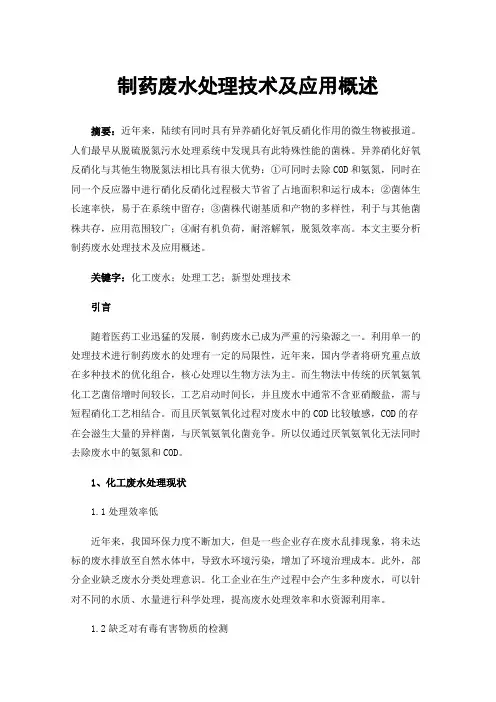
制药废水处理技术及应用概述摘要:近年来,陆续有同时具有异养硝化好氧反硝化作用的微生物被报道。
人们最早从脱硫脱氮污水处理系统中发现具有此特殊性能的菌株。
异养硝化好氧反硝化与其他生物脱氮法相比具有很大优势:①可同时去除COD和氨氮,同时在同一个反应器中进行硝化反硝化过程极大节省了占地面积和运行成本;②菌体生长速率快,易于在系统中留存;③菌株代谢基质和产物的多样性,利于与其他菌株共存,应用范围较广;④耐有机负荷,耐溶解氧,脱氮效率高。
本文主要分析制药废水处理技术及应用概述。
关键字:化工废水;处理工艺;新型处理技术引言随着医药工业迅猛的发展,制药废水已成为严重的污染源之一。
利用单一的处理技术进行制药废水的处理有一定的局限性,近年来,国内学者将研究重点放在多种技术的优化组合,核心处理以生物方法为主。
而生物法中传统的厌氧氨氧化工艺菌倍增时间较长,工艺启动时间长,并且废水中通常不含亚硝酸盐,需与短程硝化工艺相结合。
而且厌氧氨氧化过程对废水中的COD比较敏感,COD的存在会滋生大量的异样菌,与厌氧氨氧化菌竞争。
所以仅通过厌氧氨氧化无法同时去除废水中的氨氮和COD。
1、化工废水处理现状1.1处理效率低近年来,我国环保力度不断加大,但是一些企业存在废水乱排现象,将未达标的废水排放至自然水体中,导致水环境污染,增加了环境治理成本。
此外,部分企业缺乏废水分类处理意识。
化工企业在生产过程中会产生多种废水,可以针对不同的水质、水量进行科学处理,提高废水处理效率和水资源利用率。
1.2缺乏对有毒有害物质的检测化工废水含有多种污染物,而化工企业出水检测往往只针对常规污染物,容易忽视有毒有害物质。
这些物质在常规处理过程中难以降解,如有机氯、有机汞、重铬酸钾、三氧化二砷和苯系物等。
如未有效处理,它们将会伴随废水排放进入自然环境中,如果转移到食物链中,还会威胁人体健康。
因此,加强对有毒有害物质的检测,不断改进废水处理工艺,提高废水处理效率,是化工废水处理的主要发展方向。
Voe.50 No.5May2021第50卷第5期2021年5月应用化工Applied Chemical Indust/硼掺杂金刚石电极电解水制备臭氧技术研究李海云V ,衣颖2,范云双1,马军2,赵蕾2,朱孟府2,邓橙2(1-天津工业大学环境科学与工程学院,天津300387;2.军事科学院系统工程研究院卫勤保障技术研究所,天津300161)摘 要:以硼掺杂金刚石(BDD )为电极,设计出膜电极一体化(MEA )反应器,采用SEM &XRD 及Raman 光谱等技术对电极进行表征分析,考察了电极材料、电流密度、电解液流速及电导率对臭氧产生性能的影响。
结果表明,BDD 电极是结晶度良好、高纯度的金刚石晶体,产生臭氧的最佳条件为:电流密度33 mA/cm 2,电解液流速15 mL/min 、 电导率1 'S/cm 。
在此条件下,臭氧产量为29.1 my/h ,产生臭氧的电流效率高达48. 73%,能耗低至115 W * h/g 。
关键词:臭氧;硼掺杂金刚石;膜电极;电解水中图分类号:TQ151.1;O 633 文献标识码:A 文章编号:1671 -3206(2021)05 -1254 -05Sthdy on production of ozone by electrolysis of water withboron-doped diamond electrodesLI Hai-yun ,2,YI Ying 2,FAN Yun-shuang 1,MA Jun 2,ZHAO Lee ,ZHU Meng(F ,DENG Cheng?(1. School of Environmental Science and Enginee/ng,Tianjin Polytechnic UniversPy,Tianjin 300387,China ;2. Institute of Med/ai Support 16—2010X1 ,Academy of Mi/ta/ Science of Chinese PL A ,T/njin 300161,China )Abstract : MEA /actor was fab/cated to car / out with bo/n-doped diamond ( BDD ) as the electrode -TheSEM %XRDand Raman 4pecteo4copyweeeu4ed tochaeacteeoeetheBDDeeecteode.Thee o ectooeeec-teodemateeoaecu e ntden4otyeeecteoeyteoeoweateand conductoeotyon oeonepeoductoon haeebeen onee4-togated.Theee4uet4howthattheBDDeeecteodeoadoamond cey4taewoth good cey4ta e onotyand hogh pueo- ty. Under the condition of current density of 33 mA/cm 2,emct/lyta Wow rata of 15 mL/min ,and electro-eyt conductoeotyoo1 'S Bcm %th*o eon*output os29. 1 mgBh.Th*cu e *nt*o oconcyoooeon*osashogh as 48 .73% %and th**n*egyconsumptoon osaseowas115 W *h Bg.Key worps : ozone ; bo/n-doped diamond ; solid polymer electrolyte ; electrolysis of water近年来,高级氧化技术特别是臭氧催化氧化因其氧化能力强、反应时间快、无二次污染等优势,在解决水污染尤其是水中有机物的去除方面展现出了 极大的潜力(1甲]。
化工进展Chemical Industry and Engineering Progress2024 年第 43 卷第 4 期两电子水氧化反应抑制掺硼金刚石电极氧化有机物过程中氯酸盐和高氯酸盐的生成丁嘉1,2,吴文琦3,李鹏程1(1 上海市政工程设计研究总院(集团)有限公司,上海 200082;2 浙江大学环境与资源学院,浙江 杭州 310012;3国家电网杭州供电公司,浙江 杭州 310000)摘要:掺硼金刚石(BDD )具有羟基自由基(·OH )产率高、稳定性好的优点,作为电极材料被广泛应用于难降解有机物的处理。
但BDD 电极在处理含氯介质时产生的高毒性副产物——氯酸盐(ClO -3)和高氯酸盐(ClO -4)是限制其广泛应用的关键障碍之一。
本文通过两电子水氧化反应(2e -WOR )来控制BDD 电极氧化过程中ClO -3和ClO -4的产生。
同时,以一种广泛使用的除草剂——阿特拉津(ATZ )为模型污染物,探究2e -WOR 对有机物降解效果的影响。
研究表明,NaHCO 3作为电解质可以有效催化BDD 电极上的2e -WOR ,进而降低电解过程中活性氯、ClO -3和ClO -4的浓度。
添加10mmol/L NaHCO 3后,活性氯浓度下降了60.3%,ClO -3和ClO -4的生成速率常数分别下降10.2%和39.2%。
当添加50mmol/L 和100mmol/L NaHCO 3时,活性氯的生成被完全抑制,ClO -3的生成速率常数分别降低了60.0%和72.5%,ClO -4的生成速率常数分别降低了66.2%和72.6%。
2e -WOR 对ClO -3和ClO 4-抑制作用的机理有两个方面:①2e -WOR 产生的H 2O 2与活性氯反应,降低了关键中间物的浓度,进而控制了ClO -3和ClO -4的生成;②HCO -3与ClO -3竞争·OH 反应,降低了ClO -3向ClO -4的转化速率。
猱艺科枚Journal of Green Science and Technology第23卷第10期2021年5月电化学技术处理氨氮废水的研究进展李进松,万东锦(河南工业大学环境工程学院,河南郑州450001)摘要:随着人类社会的快速发展,带来了严重的环境污■染问题,环境治理技术已成为研究热点,其中电化学氧化技术由于自控程度高、占地面积小、处理彻底、无二次污染等优势受到科研人员注意。
目前已有大量 电化学技术在环境治理领域应用的研究,但普遍研究不够深入,设计开发的反应器也大多尚处于实验室小 试阶段,该技术有待进一步深化研究。
以氨氮为处理对象,以机理探索、电极材料制备、反应器设计、电解 液选择以及操作条件优化为研究重点,综述了电化学技术处理氨氮废水餉研究进展,并对电化学氧化氨氮遇到的技术难关和发展建议进行了详细探讨。
关键词:电化学;水处理;氨氮;彩响因素中图分类号:X830 文献标识码:A 文章编号:1674-9944(2021)10-0119-041引言氨氮是废水中重要污染物,也是水质监测指标。
当水体中氨氮含量过高会引起的水体富营养化、毒害水生 生物、产生有毒物质等多种环境问题巾。
目前主要依赖 空气吹脱、离子交换、折点加氯和生物法加以去除図,但 此类处理方法或运行成本高、或对运行环境要求严格, 都不是理想的氨氮处理技术。
基于此,科研人员尝试了电化学氧化技术对氨氮废水的处理,目前随着发电、输电技术的发展,用电成本逐 渐降低,电化学技术处理废水的应用价值日渐显现。
其中电化学处理氨氮废水研究较少,机理揭示亦以推测为 主,且尚未开发出有应用价值的电化学处理工艺,立足 于此开展电化学氧化氨氮废水研究,对推动电化学技术处理废水发展与废水中氨氮的去除具有重要意义。
2电化学氧化机理根据现有研究,电化学氧化污染物并无明显特异 性,故根据电化学氧化一般机理,电化学氧化氨氮时亦 可分为直接氧化与间接氧化两种反应。
2.1直接氧化氨氮的电化学直接氧化包括氨氮直接在电极表面 失去电子被氧化和氨氮被吸附态的轻基自由基氧化⑷O(1)氨氮吸附到电极表面,在电极上失去三个电子,被氧化去除,反应式如下。
bdd电催化氧化法BDD电催化氧化法是一种利用金刚石电极(Boron-Doped Diamond Electrode)的特殊性质,通过施加电流来实现废水中有机物的高效催化氧化的方法。
金刚石电极具有高稳定性、耐腐蚀性和良好的导电性,是一种理想的电化学催化剂。
近年来,水污染日益严重,需要寻找一种高效、环保的处理废水的方法。
传统的废水处理方法往往耗能大、污泥处理困难,而BDD电催化氧化法则可以有效地解决这些问题。
该方法能够快速、高效地氧化废水中的有机污染物,将其转化为无害的物质,从而达到废水净化的目的。
同时,该方法具有能耗低、无需添加氧化剂等特点。
因此,BDD电催化氧化法成为了一种备受关注的新型废水处理技术。
BDD电催化氧化法的工作原理是通过施加一定电流密度,使金刚石电极上的氢氧化物离子(OH-)发生催化氧化反应。
这样,废水中的有机污染物分子就会被电化学氧化成氧化产物,如二氧化碳和水等。
在这个过程中,BDD电极的高度稳定性和电化学活性起到了至关重要的作用。
BDD电催化氧化法在废水处理中具有许多优势。
首先,该方法能够处理多种有机污染物,包括易降解和难降解的有机物。
其次,该方法对于有机物的去除率高,处理效果稳定可靠。
此外,使用BDD电催化氧化法能够减少废水处理过程中产生的二次污染物,并且无需添加其他氧化剂,减少了处理成本。
在实际应用中,BDD电催化氧化法已经得到了广泛的应用。
例如,该技术可以应用于电镀废水、印染废水、制药废水以及含色度高的废水等的处理。
通过调节电流密度、溶液的pH值和废水的停留时间等操作参数,可以实现对特定废水的高效处理。
综上所述,BDD电催化氧化法是一种环保、高效的废水处理技术。
借助金刚石电极的特殊性质,该方法能够快速、高效地将废水中的有机污染物氧化为无害的物质。
在实际应用中,BDD电催化氧化法已经显示出了广阔的应用前景。
因此,我们应该进一步加大对于BDD电催化氧化法的研究和应用,为解决水污染问题提供新思路和新方法。
电催化氧化技术处理造纸废水的实验研究覃燕;颜幼平;胡剑;伍新驰;王苏;陈志星【摘要】通过邻苯二甲酸氢钾(KHP)溶液的电解实验研究了德国引进的金属铌掺硼金刚石膜电极(Nb/BDD)的电化学性质,并利用该电极处理装置处理了东莞某造纸厂造纸废水.考察了电解时间、电流强度及废水的pH值、电解质的浓度、电导率等参数对电化学降解效率的影响.结果表明,Nb/BDD具有优异的污水降解性能,在pH 值为3.0,电流密度为37.23 mA/cm2,电压6.9V,NaCl充当电解质质量浓度0.4g/L的条件下,电解200 min,装置对再生纸造纸废水的COD的去除率接近70%,BOD/COD为0.4,比能耗为27.6(kW· h/kg).【期刊名称】《工业安全与环保》【年(卷),期】2013(039)002【总页数】4页(P21-23,28)【关键词】Nb/BDD;电催化氧化;造纸废水【作者】覃燕;颜幼平;胡剑;伍新驰;王苏;陈志星【作者单位】广东工业大学环境科学与工程学院广州510006;广东工业大学环境科学与工程学院广州510006;广东工业大学环境科学与工程学院广州510006;广东工业大学环境科学与工程学院广州510006;广东工业大学环境科学与工程学院广州510006;广东工业大学环境科学与工程学院广州510006【正文语种】中文0 引言电化学氧化技术是AOP技术的一种,因其具有其他处理方法难以比拟的优越性,近年来受到极大关注[1]。
金刚石具有极高的硬度和很好的化学稳定性,可以应用在其他材料无法应用的苛刻环境中[2]。
在制备金刚石膜过程中掺入硼元素,制备得到的硼掺杂金刚石膜具有良好的导电性能和半导体光电性质,如将其沉积到一些电极基体如钛片、硅片、石墨等表面上,研制得到的掺硼金刚石膜电极(Boron-Doped Diamond film electrode,简称 BDD)材料,在物理、化学、生物等方面已显示出了极好的应用前景[3-5],在水溶液中电解时具有很宽的电化学窗口、很小的背景电流、很高的化学和电化学稳定性、没有有机物和生物化合物的吸附、耐腐蚀等优点。